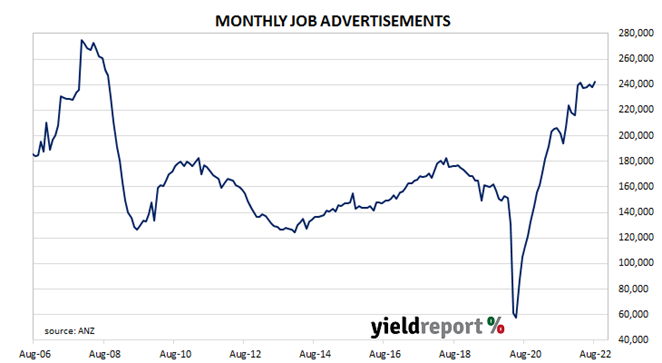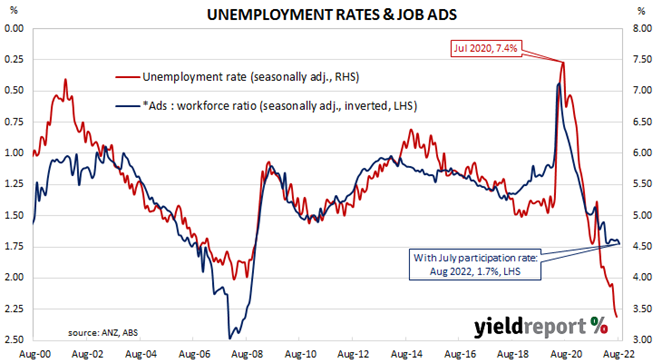Summary: Job ads up 2.0% in August; 20.2% higher than August 2021; exceeds March high; July job, participation falls “temporary reversions after rapid improvements” to fall; ads-to-workforce ratio steady at 1.7%.
From mid-2017 onwards, year-on-year growth rates in the total number of Australian job advertisements consistently exceeded 10%. That was until mid-2018 when the annual growth rate fell back markedly. 2019 was notable for its reduced employment advertising and this trend continued into the first quarter of 2020. Advertising plunged in April and May of 2020 as pandemic restrictions took effect but then recovered quite quickly.
According to the latest ANZ figures, total advertisements increased by 2.0% in August on a seasonally adjusted basis. The rise followed a 1.0% decline in July and a 0.7% increase in June after revisions. On a 12-month basis, total job advertisements were 20.2% higher than in August 2021, up from July’s revised figure of 15.3%.
“Last month, we hypothesised that ANZ Job Ads had passed its peak, but we have been proven wrong, as it increased 2.0% in August, exceeding the March high,” said ANZ senior economist Catherine Birch.
The figures were released on the same day as the Melbourne Institute’s latest reading of its Inflation Gauge and Commonwealth Government bond yields were largely unchanged except at the ultra-long end. By the close of business, the 3-year ACGB yield had slipped 1bp to 3.31%, the 10-year yield had returned to its starting point at 3.66% while the 20-year yield finished 4bps higher at 3.98%.
In the cash futures market, expectations of higher rates softened slightly. At the end of the day, contracts implied the cash rate would rise from the current rate of 1.81% to 2.18% in September, increase to 2.59% in October and then to 2.965% in November. May 2023 contracts implied a 3.775% cash rate and May 2023 contracts implied 3.84%.
“We think the falls in employment and participation in July’s labour force survey were temporary reversions after rapid improvements over recent months,” added Birch. “We continue to expect solid employment growth over the remainder of the year, underpinned by the significant volume of unfilled labour demand.”
The inverse relationship between job advertisements and the unemployment rate has been quite strong (see below chart), although ANZ themselves called the relationship between the two series into question in early 2019. A rising number of job advertisements as a proportion of the labour force is suggestive of lower unemployment rates in the near future while a falling ratio suggests higher unemployment rates will follow. August’s ads-to-workforce ratio remained unchanged at 1.7%.
In 2008/2009, advertisements plummeted and Australia’s unemployment rate jumped from 4% to nearly 6% over a period of 15 months. When a more dramatic fall in advertisements took place in April 2020, the unemployment rate responded much more quickly.



